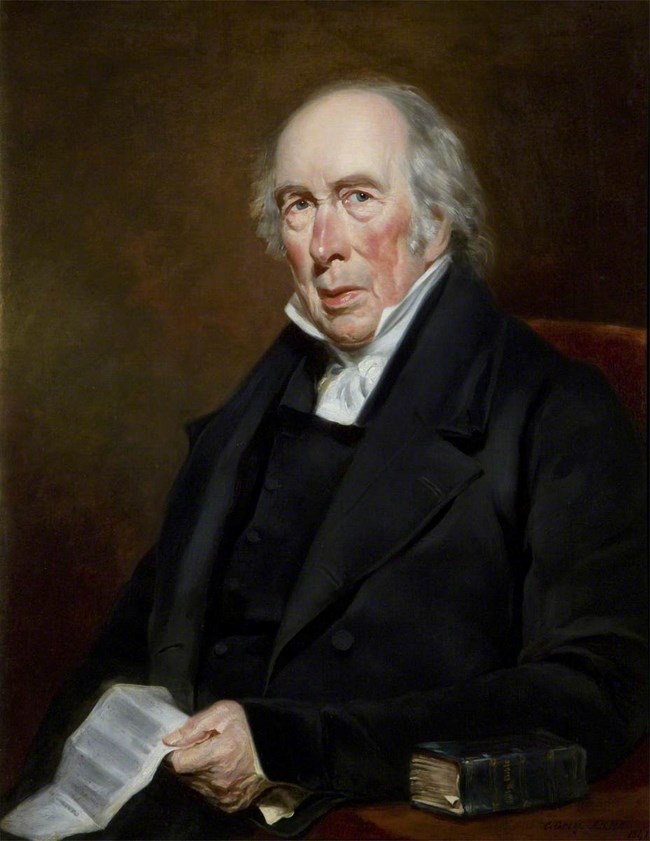Last updated: January 22, 2023
Article
Alexander Chesney

Ulster Museum
After British forces captured Charleston on May 12, 1780, Chesney responded to General Henry Clinton’s call for colonists to defend the imperial government by joining Loyalist militia forces under the command of Major Patrick Ferguson. He participated in several successful victories against Whig forces, serving as a Lieutenant and Captain within Loyalist militia regiments over the next few months.[4] But Chesney suffered defeat and gunshot wounds at the Battle of Kings Mountain on October 7, 1780. Patriot soldiers then marched him towards Gilbert Town, stripping him of his shoes and denying him “covering or provisions.” At Gilbert Town, Chesney claimed that the Whigs conducted a “mock [trial]” in which they sentenced 24 Loyalists to death. Patriot soldiers then forced Chesney and their other prisoners to march towards the Yadkin River, “cutting and striking us by the road in a savage manner.”[5] Even though Whig Colonel Benjamin Cleveland offered to release him if he taught Patriot militia soldiers Ferguson’s exercises, Chesney refused this offer, preferring to remain as a prisoner rather than betray the Loyalist cause. He, fortunately, escaped Patriot forces while in route with other prisoners to Salem, North Carolina, hiding out in a cave before Patriot soldiers recaptured and exchanged him for another prisoner held by Patriots.[6]
By January 1781, Chesney formed a militia company to fight under Lieutenant Colonel Banastre Tarleton, who had commanded British forces to victory at the Battle of Waxhaws, Battle of Camden, and other engagements in South Carolina over the past year. He assisted in guiding Tarleton from the British encampment at Fort Ninety-Six through the Pacolet River area in search of Whig General Daniel Morgan.[7] In the days leading up to the Battle of Cowpens, soldiers under the command of Morgan occupied Chesney’s plantation at Grindal Shoals. Chesney later claimed that these Patriot troops plundered his land of almost all usable goods, including grain, trees, clothing, and blankets, likely as a conscious attempt to intimidate other Loyalists in the neighboring area.[8]
On the day of the battle January 17, 1781, Tarleton consulted Chesney and his other guides on the topography of the surrounding area, with his view of the front line of Patriot soldiers obstructed by trees and elevated terrain. Despite his poor visibility of the opposing troops and the British soldiers’ fatigue in having marched since 2 AM that morning, Tarleton ordered an attack on the opposing three lines of Patriot soldiers. After the first two lines of Patriot sharpshooters and militia units fired several volleys and then retreated about 150 yards to the next line of defense, British forces advanced closer towards the third line of Continental soldiers. The Continentals then exchanged fire with the British and organized a bayonet charge against the depleted British troops. As the Continental soldiers charged forward, Patriot militia and cavalry units attacked the left and right flanks of the British forces, creating a double envelopment that surrounded Tarleton’s forces. Chesney led a Loyalist militia unit during the engagement, which he judged to be “a total defeat” resulting from “dreadful [sic] bad management.”[9] He found that this defeat in which the Americans either killed, wounded, or captured roughly 86 percent of the British soldiers at the battle arose because of how “imprudently” Tarleton acted in this decision to charge at the Patriot lines.[10]
With his plantation at Grindal Shoals having been raided by Morgan’s soldiers, Chesney relocated to Charleston following the British defeat at Cowpens. He continued to lead Loyalist militia in several other skirmishes against Patriot forces near the Edisto River before fleeing to Castle Haven, Ireland on May 19, 1782. Chesney later served as a captain in the British military for most of the remainder of his life while residing in Ireland and Britain.[11] Like many Loyalist colonists during the Revolution, he fought with great passion and determination against the cause to rebel against the British Empire and suffered harsh consequences for these convictions.
[1] Melissa Walker, The Battles of Kings Mountain and Cowpens: The American Revolution in the Southern Backcountry (New York and London: Routledge, 2013), 38-39.
[2] Alexander Chesney, The Journal of Alexander Chesney, A South Carolina Loyalist in the Revolution and After, ed. E. Alfred Jones and Wilbur Henry Siebert (Columbus, OH: Ohio State University, 1921), https://www.google.com/books/edition/The_Journal_of_Alexander_Chesney/pYD3dEoff-gC?hl=en&gbpv=0, 6-7.
[3] Ibid., 5-6.
[4] Norman Desmarais, The Guide to the American Revolutionary War in South Carolina: Battles, Raids, and Skirmishes (Ithaca, NY: Busca, Inc., 2012), 19, 21, 42.
[5] Chesney, Journal of Alexander Chesney, 18-19.
[6] John Buchanan, The Road to Guilford Courthouse: The American Revolution in the Carolinas (New York: John Wiley & Sons, Inc., 1997), 228-233, 241.
[7] Chesney, Journal of Alexander Chesney, 20-21.
[8] Lawrence E. Babits, A Devil of a Whipping: The Battle of Cowpens (Chapel Hill, NC: University of North Carolina Press, 1998), 48.
[9] Chesney, Journal of Alexander Chesney, 21-22.
[10] Buchannan, The Road to Guilford Courthouse, 326; Chesney, Journal of Alexander Chesney, 22.
[11] Chesney, Journal of Alexander Chesney, iv-xii.
